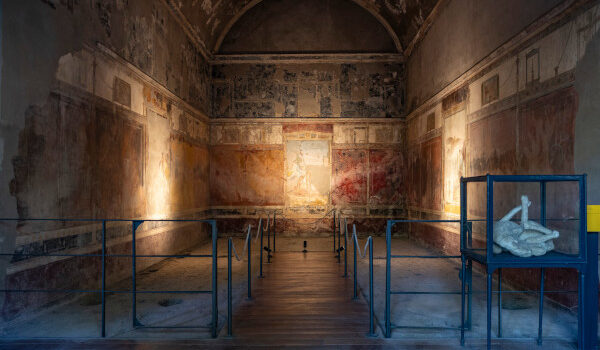CLOSURE OF THE ANTIQUARIUM AND OPENING OF THE IMPERIAL VILLA, THE HOUSE OF TRYPTOLEMUS, AND THE HOUSE OF THE SAILOR
We would like to inform you that as of August 1, 2024, the Antiquarium of the Pompeii will close for maintenance work and the refitting of some of the exhibition spaces.
Three of the casts on display at the Antiquarium will now be displayed in the Imperial Villa which is accessible from the lower entrance to the Antiquarium. In addition, the House of the Sailor and the House of Tryptolemus will be both be open to visit.
The bookshop on the upper floor of the Antiquarium will remain open, and the elevator will be in regular use to ensure accessibility for wheelchair users along the “Pompeii for All” route.
The Imperial Villa (opens 9:15 - closes 18:20, last entrance 18:00)
The Imperial Villa, so named due to the splendour of its paintings, is a vast residence which was built alongside the walls and scenically laid out on terraces across several levels, all sloping towards the sea. The large and luxurious rooms were decorated with beautiful frescoes and geometrically patterned marble floors, of which only traces survive, left by the slabs on the floor preparatory layer.
The prestigious residence, which was first opened to the public in April 2016, contains reproduction furniture which allows for an immersive experience of everyday life in ancient times. The cubiculum, or bedroom, is arranged with all of its furnishings: the bed, benches, candelabra, lamps and boxes for documents. The large triclinium contains the beds upon which one would eat partially lying down, along with small tables and beautiful vessels in bronze, glass and ceramic, which were used for banquets.
The Villa was constructed during the 1st century AD, and was destroyed by the earthquake of AD 62; at the time of the eruption it was undergoing demolition.
The House of the Sailor (opens 9:15 - closes 18:20, last entrance 18:00)
The house, whose layout dates back to the 2nd century BC, required a great construction commitment since the significant difference in height between the various areas throughout had to be compensated for by constructing vaulted semi-hypogean rooms used as a warehouse.
The presence of a vast commercial and productive area within an elegant townhouse is an exception in Pompeii. The main rooms of the house open on to an impressive atrium, which was redecorated at the end of the 1st century BC with several interesting black and white mosaics. A small thermal complex was also added at the time. The house, unearthed since 1871, owes its name to the mosaic with six prows of ships within arsenals at the entrance, an allusion to the peaceful haven offered to its occupants and perhaps even to the amateur activity of the owner.
The House of Tryptolemus (opens 9:15 - closes 18:20, last entrance 18:00)
The House of Tryptolemus opens onto one of the most prestigious areas of the city, in front of the Basilica and near the Forum, the centre of political and commercial life. It owes its name to the famous fresco in the triclinium depicting Tryptolemus, the hero who transmitted the knowledge of agriculture to men, while receiving a basket of spikes from the goddess Persephone. The house has undergone restoration works in 2014 which gave new life to the beautiful frescoes and mosaics. The most important environment of the house is the one that opens onto the back of the courtyard, which has a mosaic floor with a very rare decoration in perspective cubes similar to that found in the cell of the nearby Temple of Apollo and in the Temple of Jupiter. to the house a particular importance and elegance.
The house was built in the second century. B.C. and it was profoundly renewed after the conquest of Sulla of 80 B.C. with new and refined frescoes, which bear witness to the wealth and importance of the owner.


